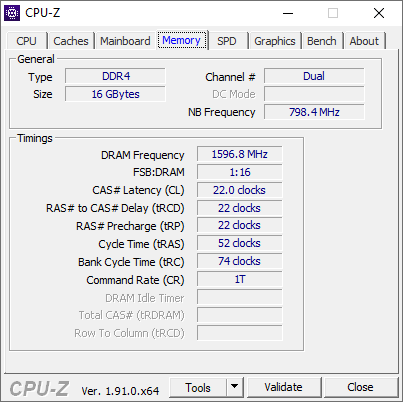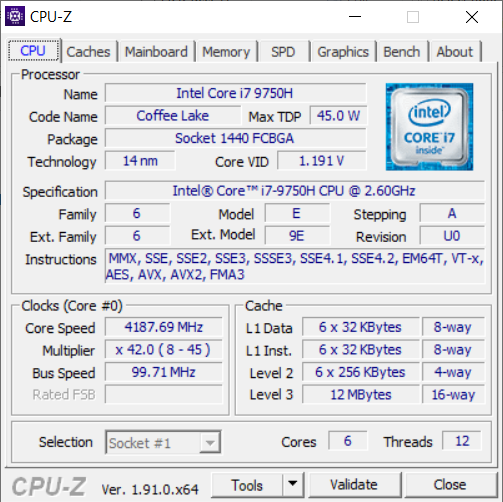AMD’s Mobile Revival: Redefining the Notebook Business with the Ryzen 9 4900HS (A Review)
by Dr. Ian Cutress on April 9, 2020 9:00 AM ESTCPU Benchmarks
Comparison of these two CPUs is going to be interesting. Both laptops being tested excel in different ways:
| ASUS Zephyrus G14 vs Razer Blade 15 | ||
| ASUS Zephyrus G14 |
AnandTech | Razer Blade 15-inch |
| Ryzen 9 4900HS | CPU | Core i7-9750H |
| 8 / 16 | Cores / Threads | 6 / 12 |
| 1400 MHz | Idle Frequency | 1100 MHz |
| 3000 MHz | Base Frequency | 2600 MHz |
| 4300 MHz | Rated 1T Turbo | 4500 MHz |
| 4500 MHz | Measured 1T Turbo | 4200 MHz |
| 35 W | TDP Listed | 45 W |
| - | TDP Measured | 35 W |
| - | PL2 Listed | 60 W |
| - | PL2 Measured | 45 W |
| 16 GB DDR4-3200 22-22-22 1T |
DRAM | 16 GB DDR4-2666 19-19-19 2T |
The ASUS device has more cores, and by the looks of our testing, actually turbos to a higher frequency, regardless of the sticker on the box. We’ve already shown that AMD’s Zen 2 can have comparable if not better IPC than Intel’s Coffee Lake refresh, so add that to the more cores, should put every test in AMD’s camp.
What should benefit Intel here is the on-box TDP, of 45 W, compared to the AMD 35 W. When we fired up our usual program for monitoring Intel frequencies, it showed that there is a hard coded BIOS boost up to 60 W, which we thought should give some extra power. However, when the system was actually set to a workload, the peak turbo power was only 45 W, which the system was able to keep for 10-15 seconds. Then it sat back at 35 W, which makes it in line with AMD. This is odd performance from the Intel CPU, however we assume at this level that Razer has made the decisions in order to fit within the thermal profile of the Blade 15 chassis.
If Intel has a lower frequency, fewer cores, and a lower frequency, all for the same power envelope as AMD, then it looks like a slam dunk for AMD.








It is. These systems are built with productivity in mind, and even with benchmarks that are bursty like PCMark, AMD takes the win.

I also took some time to run the Civ 6 AI benchmarks, which performs 10 turns of a late game and averages the turn time. Intel won this test, but I performed it again with the power unplugged and on battery saver mode in Windows. The results were reversed:

This led me to do some more tests without power connected. I’ve separated these out into a different page, combining some CPU and some GPU data.














267 Comments
View All Comments
guachi - Thursday, April 9, 2020 - link
I was looking at the very Razer you had in this review. Ended up preordering the Asus.So I thank you for the review and the comparison choice.
Mat3 - Thursday, April 9, 2020 - link
I know that's not a real die shot, but even so, that's the worst "fake" die shot I've ever seen.StevoLincolnite - Thursday, April 9, 2020 - link
I have a Ryzen 2700u notebook which I will happily toss out the window for this.ballsystemlord - Thursday, April 9, 2020 - link
Spelling and grammar errors:"If Intel has a lower frequency, fewer cores, and a lower frequency, all for the same power envelope as AMD, then it looks like a slam dunk for AMD."
Double "lower frequency":
"If Intel has a fewer cores and a lower frequency, all for the same power envelope as AMD, then it looks like a slam dunk for AMD."
"When the system does the battery life done right, it's crazy good."
Badly worded:
"When the system balances performance and battery life, it's crazy good."
mkozakewich - Thursday, April 9, 2020 - link
On these kinds of systems, battery life can tank when something goes wrong. I wonder if there was also a reason that the Intel system was showing such poor battery life.When AnandTech reviewed the Surface Book, I remember them giving it a really low battery life score. It turns out there's some kind of problem with the GPU connection, and the device will get twice the life if you disconnect and reconnect the tablet portion multiple times. I actually get 12 hours on my 2017 Surface Book 2. The system can run on 4 W. So, finally! I've never even considered an AMD system, because they would run closer to 8 or 12 watts, and that meant they'd either have a massive and heavy battery, or they'd only last a few hours.
But the caveat: As you see here, and with the Surface Book, that efficiency can go out the window if one thing goes wrong.
zodiacfml - Thursday, April 9, 2020 - link
Thanks for the Anandtech quality review. I hope we see cheaper 8 core laptops without discrete graphics. Seeing the performance of the iGPU on two memory speeds, hope to see AMD with integrated memory in its future products like what they did in the PS5/Series X, great for mobile and compact desktop PCsplonk420 - Friday, April 10, 2020 - link
thanks for the latency numbers! huuuuge help for emulation fans (or at least PS3 emulation fans)!deil - Friday, April 10, 2020 - link
a bit high idle speed, but that response times is what we want most for "snappy laptop" which feels fast. I really want one now...Haawser - Friday, April 10, 2020 - link
Hey Ian, could you do some iGPU game tests with a 720p render target, but running full screen with RIS ? I'd be interested to see if you can get much higher frame rates but without a massive loss of subjective IQ ? Cheers.Fulljack - Friday, April 10, 2020 - link
I'm interested with AMD 25x20 initiative. Could you please make an update for it? Last time you did was two years ago back in 2018. It would be an interesting piece of article to show how much AMD has grown. Thanks!https://www.anandtech.com/show/13326/amd-updates-i...